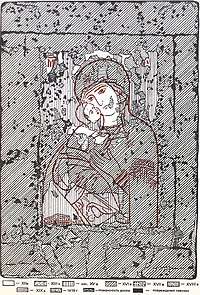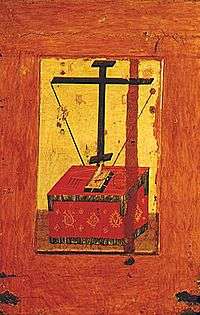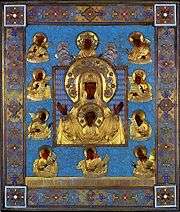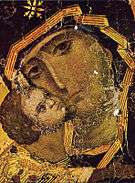Virgin of Vladimir
The Virgin of Vladimir, also known as Vladimir Mother of God, Our Lady of Vladimir[1] (Russian: Влади́мирская ико́на Бо́жией Ма́тери, Ukrainian: Вишгородська ікона Божої Матері, and the Theotokos of Vladimir (Greek: Θεοτόκος του Βλαντίμιρ), is a 12th-century Byzantine icon depicting the Virgin and Child and an early example of the Eleusa iconographic type. It is one of the most culturally significant and celebrated pieces of art in Russian history. Many consider it a national palladium with several miracles of historical importance to Russia being attributed to the icon. Following its near destruction in the thirteenth century, the work has been restored at least five times.

The icon was painted by an unknown artist most likely in Constantinople. It was sent to Kiev as a gift before being transferred to the Assumption Cathedral in Vladimir. It is traditionally said that the icon did not leave the city until 1395, when it was brought to Moscow to protect the city from an invasion by Timur, although the historical accuracy of this claim is uncertain. By at least the sixteenth century, it was in the Dormition Cathedral in Moscow where it remained until it was moved to the State Tretyakov Gallery after the Russian Revolution.
It was subject to an ownership dispute in the 1990s between the gallery and Moscow Patriarchate, which ended with its relocation to the Church of St. Nicholas in Tolmachi. An arrangement was made to operate the church with dual status as a house church and part of the museum. The icon remains there today and is only accessible via an underground passage from the gallery to the church, where liturgies are still held.
History
Origins
The icon is dated to the earlier part of the 12th century, and arrived in Russia around 1131. This is consistent with the account given in the Russian Chronicles.[2][3][4][5] Similar to other high quality Byzantine works of art, it is thought to have been painted in Constantinople.[5][6][7] Only the faces are original, with the clothes repainted after suffering damage when a metal cover or riza was placed over them[2][5] and in a fire in 1195.[5][4]
In about 1131, the Greek Patriarch of Constantinople sent the icon as a gift to Grand Duke Yuri Dolgorukiy of Kiev.[8][9] Academic Sona Hoisington attributes this in part to a greater effort by Byzantines to convert and Christianize the Slavic peoples at the time.[10] It was kept in a Vyshgorod nunnery until Yuri's son, Andrey of Bogolyubovo, brought it to Vladimir in 1155.[8]
In a traditional account the horses transporting the icon had stopped near Vladimir and refused to go further. Accordingly, many Russians interpreted this as a sign that the Theotokos[lower-alpha 1] wanted the icon to stay there. The place was named Bogolyubovo, or "the one loved by God". Andrey placed it in his Bogolyubovo residence and built the Assumption Cathedral to legitimize his claim that Vladimir had replaced Kiev as Russia's principal city.[11] The icon was soon moved to the Assumption Cathedral after its consecration in 1160.[12]
Following the consecration of the Assumption Cathedral, which was soon followed by other churches dedicated to the Virgin, there is no record of the icon ever leaving Vladimir until 1395. However, its presence did not prevent the sack and burning of the city by the Mongols in 1238, when the icon was damaged in the fire. It was restored soon after the event, and again in 1431 and in 1512.[13][14][9]
Transfer to Moscow
A legend formed that the icon was painted by Luke the Evangelist from life; the first written account of this story dates back to 1512.[15] The intercession of the Theotokos through the image has also been credited with saving Moscow from Tatar hordes in 1451 and 1480.[12]
The image was brought from Vladimir to Moscow in 1395, during Tamerlane's invasion. The site where the Muscovites met the Vladimir delegation is commemorated by the Sretensky Monastery[lower-alpha 2] which is considered to be built where it occurred. However, no archeological evidence supports this claim, and much of the fifteenth-to-sixteenth century church was destroyed after renovations by the Russian Orthodox Church.[16] Vasily I of Moscow spent a night crying over the icon, and Tamerlane's armies retreated the same day. The Muscovites refused to return the icon to Vladimir and placed it in the Dormition Cathedral of the Moscow Kremlin.[17]
David Miller suggests that the icon was in fact normally still in Vladimir, with some excursions to Moscow, until the 1520s. Crediting the icon with saving Moscow in 1395 does not appear in sources until the late 15th century and the full version of the story until accounts of 1512 and then the 1560s.[18] There is less doubt that, by at least the 16th century, the Vladimirskaya was a thing of legend and associated with the growth of Russian national consciousness based on the Muscovite state.[19]
Post-revolution
Under the Bolsheviks, the icon came into the possession of the State Tretyakov Gallery.[20] Displayed as a work of art,[20] it was first put on display in the gallery in 1930 and kept there for at least the next 11 years.[21] During the Battle of Moscow, Joseph Stalin allegedly had the icon flown around the city as the Germans began to invade.[11][22] This was first described by Moscow city official Viktor Volokhov in his book Муниципальная милиция в Российской Федерации.[22]
In 1993, it was moved to the Epiphany Cathedral for a Divine Liturgy in the wake of tensions between President Boris Yeltsin and the Russian Duma. Though it was damaged during the excursion, it was soon restored and given to the Church of St. Nicholas in Tolmachi.[23][24]
Description


The icon is a tempera painting on wood, 106 by 69 centimetres (42 in × 27 in) in size, with the central 78 by 55 centimetres (31 in × 22 in) portion being original and the rest being a later expansion undertaken possibly to accommodate a larger riza. The icon depicts Jesus Christ as a child being held in the arms of his mother, Mary. They embrace cheek to cheek, with the child gazing towards and reaching for Mary. She holds him with one arm and solemnly looks out towards the viewer. The faces and hands are painted with greenish olive sankir, a mix of ochre pigment and soot, and transparent layers of brighter ochre; the child's face is rendered in a lighter shade than the mother's, perhaps to reflect the difference in their age. The child's clothes are painted with dark ochre and gold. The original painting bore the inscription ΜΡ ΘΥ, an abbreviation for 'Mother of God', of which only parts survive.[25][9]
In its nine centuries of existence, the icon has been restored and overpainted at least five times to deal with damage and deterioration, including a fifteenth century restoration thought to have been led by Andrei Rublev. It is mainly the faces of Mary and Jesus and the gold background above her head that are original twelfth-century paint. In the past, the icon has been covered with several elaborately designed oklad and riza (revetments) which caused damage to the frame. The reverse, which is much less well known, contains an image of the Hetoimasia ('prepared throne') and instruments of Christ's Passion that was painted in ca. 14th century (prior to that the reverse side had a painting of an unidentified saint).[26][25][27]


Among icons of Virgin Mary with Jesus, Our lady of Vladimir is classed as an Eleusa icon (Russian: Oumilenie), due to the tender attachment between mother and child.[28] Theologians and believers have also commented upon the icons symbology and the religious sentiments it inspires. Contemplating the icon, theologian Henri Nouwen, remarked that the Virgin's eyes glance at neither the child or the viewer but appear to "look inward and outward at once"; that her free hand gestures towards the baby to "open a space for us to approach Jesus without fear"; and, that the child is shown as "a wise man dressed in adult clothes."[29] Literary scholar, S. S. Averintsev interpreted the mix of maternal tenderness and poignant sorrow seen in Mary's expression, as representative of the emotions generated by the events of Nativity and Calvary, respectively.[28] Jesus's bare feet are seen as symbolizing his physical reality; his garments of gold, the Kingdom of Heaven; and the three stars on Mary's dress (one occluded by the child), "her virginity before, during and after her son’s birth."[30]
Its artistic quality has been highly praised. Art historian David Talbot Rice said that "[Our Lady of Vladimir] ...is admitted by all who have seen it to be one of the most outstanding religious paintings of the world."[7] Art historian George Heard Hamilton praises its "craftsmanship and conception", and notes how in its representation of the subject's faces, the icon subtly transitions from its normal use of contour lines to a refined surface texture. It is painted in an artistic style typical for Byzantine art of the period with features including smaller mouths, refined eyes, and elongating Mary's nose. However, by avoiding the use of demarcating line, as became common in later Byzantine art, and by setting up the complex interplay of the mother and child's glances, the icon adds to the illusion of life in the piece. The child's features are reminiscent of classical sculpture, though the artist renders an expression truer to an actual infant's.[9] The expressive and humanistic character of the icon differentiates it from earlier Byzantine art and exemplify the artistic developments seen during the Komnenos dynasty.[4][6][7]
Significance
In Russian history
The icon is generally considered to be one of the most cherished symbols in Russian history.[23][31][32] Academic David Miller has ascribed this to its close connection to Russian national consciousness throughout its existence.[33] Its transfer from Kiev to Vladimir was used by Bogolyubsky to legitimize Vladimir's claim as the new center of government in the Rus'.[9]
Additionally, its intimate association with important Russian historical events gave Our Lady of Vladimir the distinction of being a national palladium.[9][11] The most recent of these events being the 1993 Russian constitutional crisis when it was brought to the Epiphany Cathedral at the request of Patriarch Alexy II and Mayor of Moscow Yury Luzhkov in their attempt to bring peace to the country.[22]
As a religious icon
Our Lady of Vladimir's veneration is also likely enhanced by the fact that the Theotokos is regarded as the holy protectress of Russia.[11] The venerated image has been used in celebration of coronations of tsars, elections of patriarchs, and other important ceremonies of state.[11][20][34] The icon has three feast days held throughout the year in celebration to specific events it is associated with:[12]
- 3 June [O.S. 21 May][lower-alpha 3] to celebrate Moscow's protection from Crimean Khan Mehmed Giray in 1521.
- 6 July [O.S. 23 June] for, in 1480, for their victory against Khan Ahmed during the Great Stand on the Ugra River.
- 13 September [O.S. 26 August] to commemorate the Muscovite deliverance from pending invasion by Tamerlane.[35]
Location and display

Our Lady of Vladimir is on display at the Church of St. Nicholas in Tolmachi.[36][37] As a result of an agreement between the Tretyakov and Moscow Patriarchate, the church is both an active Russian Orthodox house church and functioning museum.[14] Previously, it there had been a contentious ownership dispute between the two.[38][32]
In 1997, the Tretyakov completed a full restoration of the church.[14] Security improvements to store and display art were added, and an underground passageway was additionally made to connect it to the State Tretyakov Gallery.[39] In order to house the famous icon, a temperature controlled bulletproof glass case was commissioned.[14] On 7 September 1996, Our Lady of Vladimir was first installed in the special case located within the church, and the next day Patriarch Alexy II consecrated the church. According to Archpriest Nikolai Sokolov, the rector for the church, the case would able to withstand the firing of a Kalashnikov rifle as well as many other potential hazards.[40]
Due to its dual status as both church and museum, visitors are allowed to pray before the icon and divine Liturgies are regularly held on selected days. However, visitors can only enter the church through the Tretyakov Gallery and via the underground passageway.[14][40]
Copies and influence
.jpg)
Even more than most, the original icon has been repeatedly duplicated for centuries, and many copies also have considerable artistic and religious significance of their own.[41] According to Suzanne Massie, it became a standard for many Russian contemporary depictions of Mary.[42]
In preparation for the 1980 Summer Olympics, a chapel was constructed for athletes to be able to pray before competition which hosted a copy of the icon.[22]
See also
- Our Lady of Vladimir Church – a church in St. Petersburg dedicated to the icon
- List of oldest Russian icons
Notes
- Greek for Virgin Mary, literally meaning "Birth-Giver of God"
- "Sretenie" being the Church Slavonic term for "meeting".
- The dates provided are in both old and new style. The canonical dates for the feast days are in old style because the Russian Orthodox Church uses the Julian calendar. See Gregorian calendar § Difference between Gregorian and Julian calendar dates.
Citations
- Yegorov (2018), online.
- Weitzmann (1982), p. 17.
- Tretyakov Guide (2000), p. 280.
- Runciman (1975), p. 154.
- Miller (1968), p. 658.
- Funk & Wagnalls (2018), database.
- Rice (1946), p. 89.
- Miller (1968), pp. 660–661.
- Hamilton (1983), pp. 107–108.
- Hoisington (2019), database.
- Phillips (2011), database.
- Alekseyenko (2008), online.
- Miller (1968), pp. 658–659.
- Lebedeva (2006), online.
- Miller (1968), p. 663.
- Beliaev (1997), p. 38.
- Evans (2004), p. 165.
- Miller (1968), pp. 659–660.
- Miller (1968), pp. 669–670.
- Averintsev (1994), p. 613.
- Bakatkina (2017), pp. 44–45.
- Bakatkina (2017), p. 45.
- Russian Life (1999), p. 8.
- The Economist (1993), pp. 109–110.
- Bakatkina (2017), pp. 8–25.
- TVkultura (2014), online.
- Elkins (1993), database.
- Averintsev (1994), pp. 612–615.
- Nouwen (1985), pp. 387–389.
- Forest (2008), pp. 78–80.
- Nouwen (1985), p. 387.
- Jackson (1995), p. 344.
- Miller (1968), pp. 668–670.
- Miller (1968), p. 657.
- OCA (2016), online.
- Tretyakov Guide (2000), pp. 278–280.
- Pravda (2019), online.
- The Economist (1993), database.
- Insight Guides (2016), pp. 99–100.
- Strelchik (2012), online.
- Evans (2004), pp. 164–165.
- Massie (1980), p. 45.
References
- Alekseyenko, Anton (9 September 2008). "Vladimir Icon of the Mother of God". Orthodoxy and the World. Retrieved 12 August 2019.CS1 maint: ref=harv (link)
- Averintsev, Sergej S. (1994). "The Image of the Virgin Mary in Russian Piety". Gregorianum. Gregorian Biblical Press. 75 (4): 611–622. ISSN 0017-4114. JSTOR 23579744.CS1 maint: ref=harv (link)
- Bakatkina, Maria (5 January 2017). "Hands off That Sacred Image!" The Vladimir Icon and Its Power (PDF) (Thesis). University of Virginia. doi:10.18130/V3NQ0F. Retrieved 15 August 2019 – via LibraETD.CS1 maint: ref=harv (link)
- Beliaev, Leonid A. (July–August 1997). "Mystery Monasteries". Archaeology. Archaeological Institute of America. 50 (4): 36–38. ISSN 0003-8113. JSTOR 41658720.CS1 maint: ref=harv (link)
- Forest, Jim (2008). Praying with Icons. Orbis Books. ISBN 978-1-60833-077-5.CS1 maint: ref=harv (link)
- "Byzantine Art and Architecture". Funk & Wagnalls New World Encyclopedia. Chicago: World Book, Inc. 2018. EBSCOhost by218900.
- "Commemoration of the Vladimir Icon of the Mother of God and the deliverance of Moscow from the Invasion of Tamerlane". oca.org. The Orthodox Church in America. 26 August 2016. Retrieved 15 August 2019.
- Elkins, James (1 April 1993). "From original to copy and back again". The British Journal of Aesthetics. Oxford University Press. 33 (2): 113–120. doi:10.1093/bjaesthetics/33.2.113. ISSN 0007-0904. GALE A13772791.CS1 maint: ref=harv (link)
- Evans, Helen C., ed. (2004). Byzantium, Faith and Power (1261–1557). Metropolitan Museum of Art/Yale University Press. ISBN 978-1-58839-114-8. OCLC 893698628.CS1 maint: ref=harv (link)
- Hamilton, George Heard (1983). The art and architecture of Russia (3rd ed.). New Haven: Yale University Press. ISBN 0-300-05327-4.CS1 maint: ref=harv (link)
- Hoisington, Sona (1 March 2019). "The Middle Period". Dig into History. Cricket Media. 21 (3): 20+. ISSN 1539-7130. GALE A581990256.CS1 maint: ref=harv (link)
- Insight Guides Pocket Moscow (Travel Guide eBook). Apa Publications (UK) Limited. 2016. ISBN 978-1-78671-677-4. Retrieved 9 August 2019.
- Jackson, David (May 1995). "The State Tretyakov Gallery. Moscow". The Burlington Magazine (Review). Burlington Magazine Publications Ltd. 137 (1106): 342–344. ISSN 0007-6287. JSTOR 886644.CS1 maint: ref=harv (link)
- Kirdina, N., ed. (1 January 2000). State Tretyakov Gallery (Guidebook) (in French). Translated by Cook, K. M. (2nd rev ed.). Moscow: Avant-Garde. ISBN 978-5863941066. OCLC 54071928. OL 9058828M.
- Lebedeva, Elena (18 December 2006). "Xрам Святого Николая Чудотворца В Толмачах" [Church of St. Nicholas the Wonderworker in Tolmachi]. pravoslavie.ru (in Russian). Retrieved 11 August 2019.CS1 maint: ref=harv (link)
- Massie, Suzanne (1980). Land of the Firebird: the Beauty of Old Russia. New York City: Simon and Schuster. ISBN 0-671-23051-4.CS1 maint: ref=harv (link)
- Miller, David B. (October 1968). "Legends of the Icon of Our Lady of Vladimir: A Study of the Development of Muscovite National Consciousness". Speculum. Medieval Academy of America. 43 (4): 657–670. doi:10.2307/2855325. ISSN 0038-7134. JSTOR 2855325.CS1 maint: ref=harv (link)
- Nouwen, Henri J. M. (11 May 1985). "The Icon of the Virgin of Vladimir: An Invitation to Belong to God". America. America Media. 152 (18): 387–390. ISSN 0002-7049. EBSCOhost 35621166.CS1 maint: ref=harv (link)
- "О чем молятся Владимирской иконе Божией Матери" [About prayer for the Vladimir icon of the Mother of God]. www.ap22.ru (in Russian). Pravda. 3 June 2019. Retrieved 11 August 2019.
- "Our Lady at Rest". Russian Life. Montpelier, Vermont: Russian Information Services, Inc. 42 (5): 8. August–September 1999. ISSN 1066-999X. GALE A58065134.
- Phillips, Peter (25 June 2011). "Band of gold: the historic towns north-east of Moscow give a beautiful glimpse into the dawn of Russian civilisation". Spectator. London: The Spectator Ltd. 316 (9539): 59+. ISSN 0038-6952. GALE A259961864.CS1 maint: ref=harv (link)
- Rice, D. Talbot (April 1946). "The Greek Exhibition at Burlington House". The Burlington Magazine for Connoisseurs. 88 (517): 86–90. ISSN 0951-0788. JSTOR 869212.CS1 maint: ref=harv (link)
- Runciman, Steven (1975). Byzantine Style and Civilization. Penguin Books. ISBN 978-0-14-013754-5.CS1 maint: ref=harv (link)
- Strelchik, Evgeny (12 December 2012). "Третьяковка приглашает... в храм/Интервью/ЖМПиЦВ". Tserkovny Vestnik (Interview) (in Russian). Retrieved 12 August 2019.CS1 maint: ref=harv (link)
- "The resurrection of holy Russia". The Economist. 329 (7834). Economist Intelligence Unit N.A. Incorporated. 23 October 1993. pp. 109–110. GALE A14570055.
- "Что скрывает обратная сторона иконы Владимирской Божьей Матери?". TVkultura (in Russian). 13 March 2014. Retrieved 24 August 2019.
- Weitzmann, Kurt (1982). The Icon. London: Evans Brothers Ltd. ISBN 0-237-45645-1.CS1 maint: ref=harv (link)
- Yegorov, Oleg (12 November 2018). "5 most famous and miraculous icons that Russians venerate". Russia Beyond. Retrieved 9 August 2019.CS1 maint: ref=harv (link)
Further reading
- Beckwith, John (1970). Early Christian and Byzantine Art (2nd ed.). Penguin History of Art. ISBN 978-0-14-056033-6.
- Belz, Elaine Elizabeth (2016). "A Wounded Presence: The Virgin of Vlaidimir Icon". The Graduate Journal of Harvard Divinity School. Harvard College. Retrieved 12 August 2019.
External links
| Wikimedia Commons has media related to Our Lady of Vladimir. |
- Theotokos of Vladimir on OrthodoxWiki
- Vladimir Icon of the Mother of God at Orthodox Encyclopedia (in Russian)


